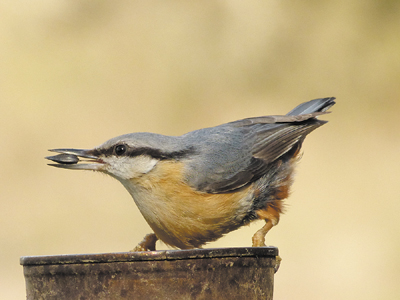The small birds that bop around our feeder a lot, and are not chickadees, are the nuthatches.
They are red-breasted nuthatches almost exclusively, though once in a while a white-breasted nuthatch shows up, which is slightly larger and, well, has a white breast instead of a rusty-colored breast.
The red-breasted nuthatches seem much more serious about what they’re doing than the black-capped chickadees. The chickadees flit and hop, take pokes at each other, and chatter in their polyphonogrammatic chickadee language (see Backyard Naturalist, Feb. 14).
The nuthatches, on the other hand, talk less and spend most of their tree time upside down. They patrol high, low and around tree trunks for beetles, ants, caterpillars and spiders, with their heads pointing mostly toward the ground and their long, sharp, flat claws finding toeholds in the cracks of the bark.
In winter, when bugs and spiders are scarce, they grab seeds out of the feeder.
They’re quick to join other species of birds on food-finding expeditions. But their bird feeder etiquette is quite a bit more refined than that of chickadees and blue jays, who often turn up in gangs and take turns stabbing at the tray with their beaks and sending seeds flying all over everywhere.
The nuthatches are usually alone, or maybe with one companion. After spending some time inspecting the tray by walking all over it upside down and sideways, as though gravity didn’t exist, they normally take one seed at a time with their longer beaks and, like the chickadees, fly off to hammer it open at another location. A study done deep in the Franklin County woods some years ago showed that nuthatches and chickadees both select seeds according to weight, indicating they’re aware that the heavier seeds contain more nut meat.
The nuthatches are, on the whole, less talkative than the chickadees, although they apparently study chickadee language in school because they understand the warning calls. Their own vocabulary has a lot of variations on a call that sounds roughly like “yank-yank-yank,” sort of a nasal cross between a crow and a duck, but tiny; a series of rapid “hn-hn-hn” notes; and a trill that apparently occurs at mating time, which I have not noticed.
Nuthatches seem to live in small groups of two or three birds; researchers have noted male pairs living together in the same small territory. The males are said to be aggressively protective of their nests, especially while the female is building it, though I’ve never observed this. In fact, the nuthatches seem to conduct themselves with a sort of domestic calm-headedness, compared to the other flying residents of our woods. Being small, high-metabolism creatures, they do bustle around with jerky movements; but even their sharp motion seems more deliberate than that of the garrulous chickadees. They’re methodical but not officious, vigilant but not skittish.
Their whole demeanor looks to me as though they have, on the whole, an energetic but more serious disposition to hearth and home. They excavate holes in dead branches where they make their nests of grass, bark and pine needles, and they paint the openings with pine or spruce pitch — using their beaks or (reportedly) even a piece of bark as an applicator — whose stickiness is thought to keep predators from coming in. (That explains why we see them so frequently: Our woods are thick with spruce and fir.)
I imagine chickadees, by the feisty way they move around and chatter, have a better sense of humor than nuthatches. But their females are prone to have affairs, which is not observed among the nuthatches, who are seasonally monogamous, or at least I have not seen or read of it.
During the courtship phase, the male brings tasty caterpillars and bugs to the female and places them in her bill with his. If the off-season foraging is good, nuthatch pairs will overwinter together and nest again the next spring. When winter foraging is particularly bad, nuthatches will up and head south en masse.
Here in Troy, we have red-breasted nuthatches at the feeder all year round, so the domestic arrangements must be suiting their homespun little dispositions.
Dana Wilde lives in Troy. His writings on Maine’s natural world are collected in “The Other End of the Driveway,” available from Booklocker.com. Backyard Naturalist appears the second and fourth Thursdays of the month. You can contact him at naturalist@dwildepress.net.
Send questions/comments to the editors.





Comments are no longer available on this story